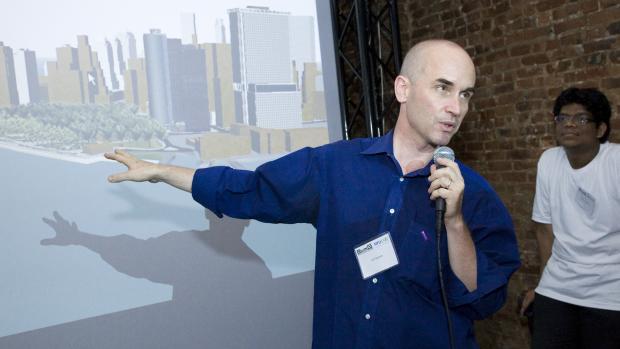Pop-Up Media Garage Asks ‘How Soon is Now’

A computer program that allows humans to intermingle electronic sound and image with emotion. Music created from a Twitter feed spilling from speakers. Alternate landscapes of the world’s largest cities that exist only in cyberspace. These may sound like ideas sprung from the brain of a 21st century H.G. Wells, but at the Brooklyn Experimental Media Center’s (BxmC) first rendition of its “pop-up” media garage in downtown Brooklyn Tuesday, June 15, the future was present.
Described as a kitchen, laboratory, and studio by Assistant Professor Carl Skelton, director of the BxmC, an arm of NYU-Poly’s art and technology programs, the space allows young and seasoned researchers and inventors to “kibitz with the door open, part of what a garage does.”
[GALLERY:3522|left]
The pop-up Garages, of which more are planned, are precursors to a permanent space slated to open in the next few years. Until then, temporary locations around Brooklyn allow the center to explore questions like what happens when a studio is also used as a storefront or even what works best when dealing with daylight and technology: a north or south facing storefront. It’s an opportunity to road test approaches before moving into the permanent space.
The projects on display, in varying stages of completion, represented a growing enthusiasm for crossover between forms of media. Betaville, a project developed by BxmC and the Media 2 Culture program of the Hochschule Bremen, Germany, and partnered with the Municipal Art Society of New York City, the Public Art Fund, the Museum of the Moving Image, and NYU-Poly research faculty, is an application that for the first time will allow a user to have a god’s eye view of a metropolis while also showing what it’s like to be on the ground.
In a demonstration at the Garage, Skelton stood before a projection of a scale model of downtown Manhattan. A small box at the top of the screen showed an urban design project created by a user for a proposed site, in this case a re-imagined version of Battery Park. By clicking on the icon, the proposed site took its place on the screen, becoming a part of the urban landscape. Once Betaville is completed, users will be able to design their own projects and post them online to share. Eventually, according to Skelton, it will even be possible to hold a smart phone in front of a physical landscape and access proposed designs virtually.
In an attempt to more fully understand the life of the mind, the Emotive Association Project, also on display at the Garage, will attempt to link visual and audio experiences with human emotion. The striking installation-screen portion of the project resembles something akin to the inside of a roughly shaken gumball machine, each piece changing speed, hue and pitch according to the parameters chosen by the user, after which the user tags their experience with an associated emotion.
A joint endeavor between BxmC and the Music Technology program at NYU Steinhardt, the project aims to create a database of user-created experiences that will be studied for future use in music and visual art pedagogy. After several thousand experiences have been tagged, researchers hope that, for the first time, audio and visual characteristics will be able to be reliably matched with a range of human emotions, resulting in more textured creative pursuits.
Other projects on view for the evening further entwined various media like Playhead, a program that reads a text feed and creates a musical score based on the shape of the letters. Short films created by students perfectly rounded out the program, showcasing what happens when we, as creative beings, combine the human experience with artistic tools at the forefront of technology. And once the Garage finds its permanent home, the frontiers of what’s possible will become not only more interesting, but possibly more familiar.




